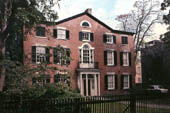 Virginia Department of Historic Resources
Virginia Department of Historic Resources Virginia Department of Historic Resources
Virginia Department of Historic ResourcesProtecting Virginia’s Historic Landmarks
Virginia’s historic landmarks are irreplaceable resources. They are tangible reminders of the state’s diverse history and traditions. Our historic buildings, neighborhoods, landscapes, and sites are essential to Virginia’s special identity and enhance the lives of both our citizens and countless visitors.
While many famous places have had their futures secured through conversion to museums or other types of public amenities, most of Virginia’s landmarks remain in private ownership and thus are vulnerable to loss or destruction through neglect or changes in land use.
Although change is inevitable, many owners of historic landmarks are concerned about the future of their properties and want to ensure the proper stewardship of these resources beyond their tenure. To meet this need, in 1966 the Commonwealth of Virginia instituted the Virginia Historic Preservation Easement Program, providing a tool that would enable historic landmarks to enjoy long-term legal protection while remaining in private ownership.

Through the easement program, a private owner has the opportunity to guarantee the perpetual protection of an important historic resource without giving up ownership, use, or enjoyment of the property. While the landmark remains in private hands and on the tax rolls, its existence and sympathetic treatment are secured for the benefit of future generations. Furthermore, the property owner can often take advantage of significant financial benefits associated with an easement donation.
For more details about historic preservation easements, visit links in the top-right box on this page. Also, for an overview of the easement program’s history, read this (2006) article (Forty Years of Preservation: Virginia’s Easement Program) authored by former DHR senior architectural historian Calder Loth.
Updated July 18, 2019